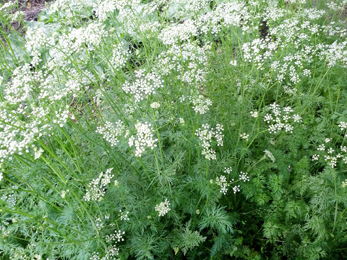Cumin (Cuminum cyminum) – Uses & Health Benefits

(Ref: Bhavaprakasa Nighantu)
Plant Description
Ideally cumin is annual plant that belongs to carrot or parsley family i.e. – Apiaceae family. Plant mostly grows up 10-30cm tall with a smooth stem. Stalks of the plant are very weak and thin but in strong plant stalks grow horizontal on the ground. Green leaves of the plant are about 7cm long and tiny flowers are white or light pink in colour. Hermaphrodite flowers contains both male stamen and female stigma. Flowers are pollinated by means of insects. Fruits are 4-5mm long and 2 mm wide. Seeds are just like caraway seeds but slightly large in size light brown in colour and strongly aromatic with little bitter in taste. After ripening of fruit seeds that are obtained are used to prepare various medicines.
According to Bhavprakash Nighantu it contains strong aromatic, volatile oil that is light yellow in colour. This volatile contains 82% cumin aldehyde and other major chemical compounds. Major chemicals present in this volatile oil is converted into thymol and thymol is very effective antiseptic that helps to kill microorganisms. It also contain some amount of static oil and pentosan.
Habitat
When we say about its original habitat of cumin than it is unknown but it is first seen in the Nile valley and from there it spread into north Africa, southwest Asia, east Mediterranean and all over in India.
From many years back this plant is cultivated in India and Iran or in words we can say that India and Iran are the biggest producers of this special herb. But now cumin is also cultivated in china, Indonesia, Sri Lanka, turkey Pakistan, southern parts of Russia and also found in Central America.
This plant loves deep nutrient rich soil in sunny areas and best grows in tropical and sub-tropical areas. In the countries with right climate seeds can be easily obtained from 4-5 month old plant in very good variety. In the warm climate areas seeds are directly sown into soil while in cold areas seeds are sown in the month of March.
Names
- Latin Name – Cuminum Cyminum
- Hindi Name – Jeera, Safed Jeera
- Sanskrit Name – Jeerak, Ajaji
- Malayalam Name – Jorekam
- Kannada Name – Jeerige
- Telugu Name – Jeelakari
- Bengali Name – Jeera, Sadajera
- Marathi Name – Jire
- Tamil Name – Cheerakam
- Gujarati Name – Jeeru
- Kashmiri Name – Safed Zoor
- Oriya Name – Dhalajera
- Punjabi Name – Safed Jira
- Urdu Name – Zirah
- Persian Name – Zireh-Sabz
- French Name – Cumin
- Spanish Name – Comino
- Italian Name – Cumino
- Arabian Name – Kamun
- Sinhalese Name – Cheeregum
Health Benefits of Cumin (Cuminum Cyminum)
According to Bhavprakash, this herb is very effective herb to stimulate digestive fire and helps to improve digestion. It helps to pacify extra aggravation of Vata dosha. Cumin is also very beneficial in treating urine retention. It is very effective pain killer and used as stimulant for our immune system. In children this herb is very beneficial for treating digestive system related disorders.
Uses of Cumin (Cuminum Cyminum)
- Intake of cumin with jaggery helps to improve appetite and reduce the burning sensation (daah) caused by fever (jawar). It is used to improve the urine retention and remove impurities of urine.
- Cumin mixed with yoghurt is helpful for treating diarrhoea. It is very beneficial herb for treating chronic diarrhoea (jiran atisaar) and also used to stimulate low fire (agnimandya).
- 1 gram of mixed powder cumin, coriander, dry rose petals and kalshimora is very beneficial for treating gonorrhoea (sujak).
- Cumin is used to increase the volume of milk in lactating mothers.
- Desi ghee mixed with cumin is helpful for treating hiccups.
- It is also helpful in voice hoarseness (swar bhang) and snake poisioning (sarpvish).
Medicinal Properties of Cumin (Cuminum Cyminum)
- Vomiting (Vaman) – cumin seeds are very beneficial for treating nausea and vomiting.
- Diarrhoea (Atisaar) – cumin is anti-diarrheal in nature and very effective herb for treating chronic diarrhoea and achy pain associated with it.
- Improve digestion (Kupachan) – cumin is very beneficial herb and stimulate low digestive fire. It is good to promote overall health of digestive system.
- Fullness of abdomen (Adhmaan) – in Ayurveda abdominal distention and fullness of stomach is major disease that is caused by vitiated vata dosha. Special type of vata that is apaan vayu is disturbed in this problem and result in the heaviness of abdomen. Cumin is very effective herb to treating this disorder and regulate natural functioning of apaan vayu.
- Fever (Jawar) – all the three doshas vata, pitta and kapha causes vataj, pittaj, kaphaj and sanipattaj types of fevers. Cumin helps to improve loss of appetite, stimulate low digestive fire and also reduce burning sensation caused by fever.
- Mutra viranjiniyan – cumin is very essential herb that helps to o improve the colour of urine. It is also very effective for treating urine retention. It improves both volume and frequency of urine.



